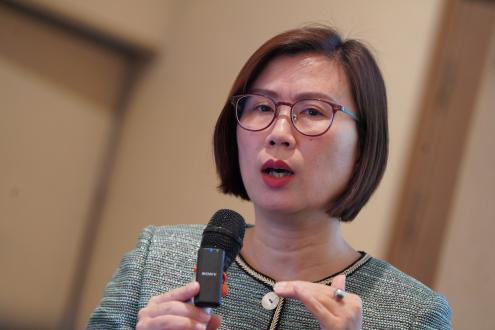The Investment Case for Vietnam and How it can Decouple from Global Markets

Jan 11, 2023
Thu Nguyen, Head of Investment, Public Equities and Fixed Income at VinaCapital in Ho Chi Minh offered delegates at the Hubbis Vietnam Wealth Management Forum in Vietnam a level and interesting presentation on the case for investing in Vietnams’ financial markets. She cited the strong economy and benign inflation, urbanisation and rapidly expanding emerging middle class, and attractive valuations of publicly traded assets.
Thu oversees the investment activities of VinaCapital’s open-ended funds and segregated mandates for both domestic and international markets. She has 19 years of experience in Asian capital markets, having worked for DBS Bank (Singapore), DBS Asset Management (Singapore) and BankInvest Group (Denmark).
Prior to joining VinaCapital in 2015, Thu was co-founder, CEO and CIO of Vietnam Asset Management, where she executed a successful track record managing several open-ended funds investing in Vietnamese equities. She has been instrumental in developing VinaCapital’s open-ended fund business to international standards. Thu holds a Bachelor of Business Administration (First Class Honours) from the National University of Singapore and is a CFA charterholder.
Vietnam’s unique qualities
“Vietnam is in a unique position to weather the current global storms,” she told delegates. “Resilience is the key word here, as the country has been one of the few in the world to deliver positive GDP growth throughout the pandemic and today. And in the first nine months of this year, our GDP has come in close to 9%. And VinaCapital has forecast full year GDP growth at 8%, driven by areas such as retail skills, manufacturing as well as construction. For 2023, we expect the Vietnamese economy to continue to deliver a very impressive growth at 5.5%, driven by the same factors.”
Core drivers of growth
She zoomed in on real retail sales growth, pointing to her slide presentation. “The resilience we see is related to Vietnam’s household balance sheet, which is very strong. People do not take out a lot of credit card loans or personal finance loans to fill their purchases. The consumer debt to GDP ratio is very modest at just 20%. As a result, real retail consumption has remained robust.”
She also highlighted production growth, helped significantly by ongoing and very strong FDI inflows in the past few years. “This year the FDI inflow growth is at 16% or equivalent to about 5% of GDP, which is significant because we are one of the few countries, or in fact, we are the country with the highest proportion of FDI to GDP amongst the ASEAN nations,” she explained.
Navigating the geopolitics
“We also continue to benefit from the China Plus One policy, and the recent surge in geopolitical tensions within Asia, especially between China and the US, have prompted a lot of industrialists, a lot of investors to come to Vietnam,” she added.
“All that is helping us transform our manufacturing sector to and shift it from the lower end manufacturing to the higher end manufacturing, which in turn gives rise to our fast growth in urbanisation as well as domestic consumption.”
The Dong – down a bit but manageable
“Actually, adjusting as VND strengthened considerably vs. USD since event in early November has sold some FX reserves, and raised interest rates twice by 100 bps to preserve the value of the currency, because stability is really key to attracting FDI and investment in general but note that the current level of foreign reserves is still at a very healthy at over three months imports. Moreover, because Vietnam’s GDP keeps rising and is a very open economy, because we have our trade balance totalling over 200% of GDP, we will still have to continue to top up this FX reserves to keep it at over three months imports level.”
Three core reasons for optimism
She said the key issue she wanted to address is whether Vietnam can actually decouple from the global slowdown. “We believe we can, not actually totally detach ourselves, but we can weather the storm because Vietnam have very good three supporting factors,” she reported.
First is the technological advancement and transformation of the industrial base and economy, making us for example now amongst the top largest exporters of high-tech products in the world, and helping boost skills and consumption.
And the second factor is the geopolitical positioning, with the country navigating relationships with both the US and China, both essential for materials and for exports. And the third element is the very strong demographics that have also helped us achieve the domestic consumption and urbanisation, which are again, key drivers for our economic growth.
Opportunities beckon
She then zoomed in on their own investment themes as a multi-asset class investment manager in Vietnam, covering sectors from real estate to private equities, listed equities, and fixed income and even venture capital and clean energy. “I will focus on listed equities today, where we are excited by companies driven by the emerging middle-income class, where GDP per capita is now at the very sweet spot of close to USD4000 and growing rapidly. This makes us a very attractive retail market, and indeed we have seen a lot of retailers from Thailand, from Korea and from Japan, have come to Vietnam to acquire stakes in retailing businesses as well as F&B businesses.”
And she added poor people are fewer and fewer in Vietnam, so wealth is spreading across the board, so too consumption, and urbanisation, leading to great opportunity for companies in construction materials as well as residential property.
And the third theme is digitalisation. Especially with such a fast-growing young population, increasingly urbanised and educated, and very much digital natives by birth and aptitude. “We visit some 300 companies each year and we see this rising investment in and commitment to digitisation across all business segments. One particular bank that we invest in has an IT workforce that is 18% of their total workforce.”
Cheap entry points
“On November 8, yesterday, the forward PE level of Vietnam dropped to 9.5x, significantly lower than the other ASEAN peers, despite historically better EPS growth. And strangely enough, Thai companies come here, make EPS accretive acquisitions, and are uprated at home.” Vietnam's discount to other ASEAN countries is nearly 35%, vs a historical average of a 10% discount.
Her final word was that there is no substitute in a frontier market like Vietnam for having people on the ground to understand the local culture and nuances. “We understand this market and have achieved some very encouraging returns on our funds, which we manage actively,” she concluded. “Yes, there are some risks here, but the opportunities are greater. We have been able to deliver about a 10% vs a flat index return while at the same time delivering a better-quality portfolio in the sense of lower PE and higher EPS growth.”

Managing Director, Head of Investment at VinaCapital

More from Thu Nguyen, VinaCapital
Latest Articles






